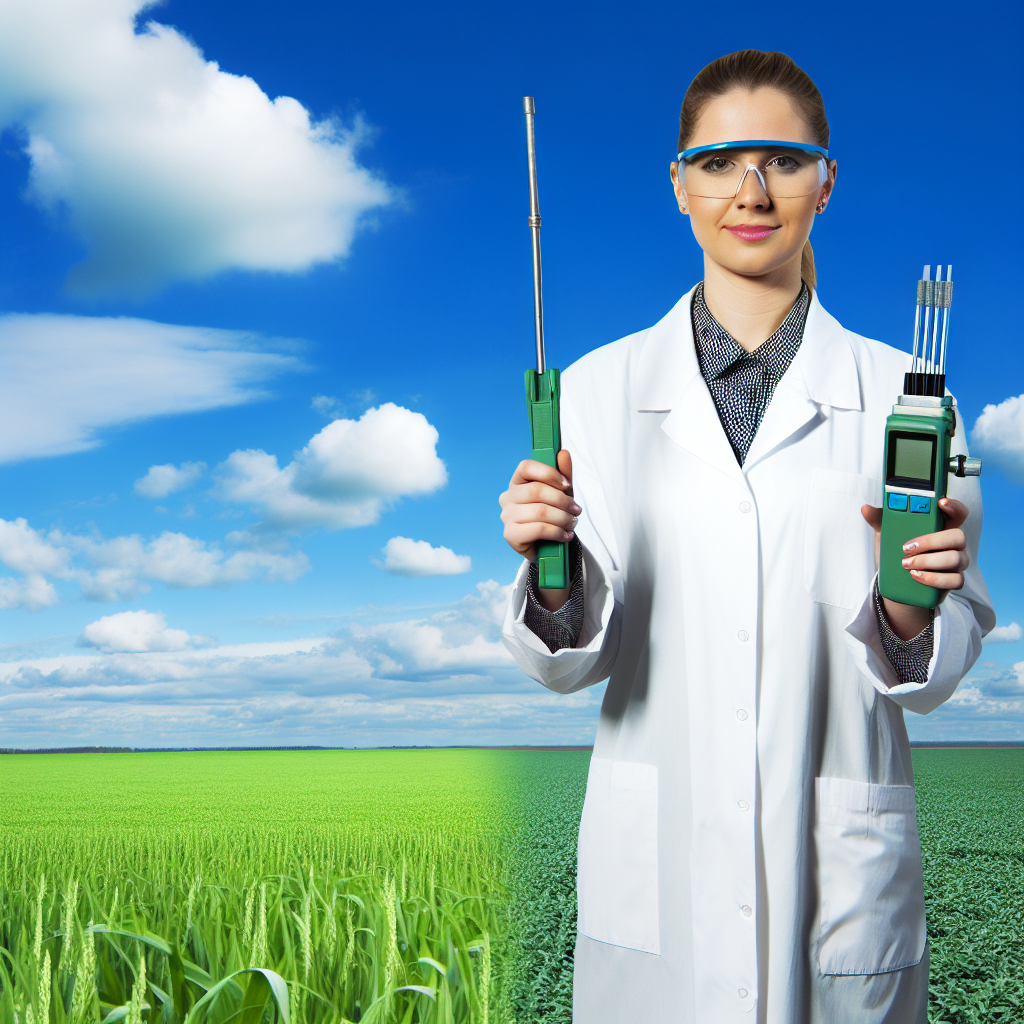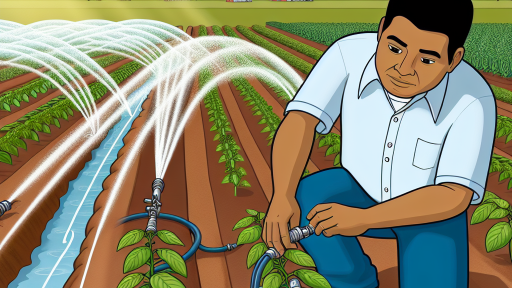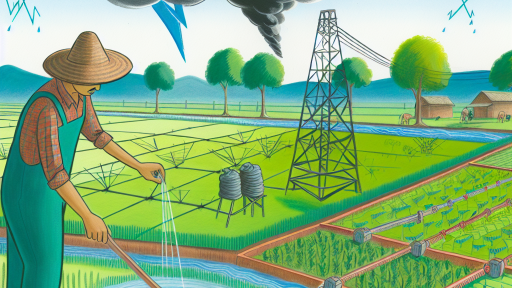Introduction to Greenhouse Gases and Agricultural Productivity
Greenhouse gases (GHGs) significantly influence our planet’s climate.
They contribute to global warming through heat retention in the atmosphere.
In turn, this warming has direct effects on agricultural productivity.
Farmers rely on stable weather patterns for optimal crop growth.
However, GHG emissions are causing erratic weather changes.
Higher temperatures can lead to reduced yields in many crops.
Moreover, GHGs affect soil health which is critical for farming.
Soil degradation results from increased erosion and nutrient depletion.
Additionally, GHGs can alter pest and disease dynamics.
Some pests thrive in warmer conditions, increasing crop threat levels.
This change can mean more pesticide use, raising production costs.
Consequently, all these factors contribute to a complex situation for farmers.
To counteract these challenges, innovative practices in agriculture are essential.
Farmers are actively seeking sustainable methods to adapt to climate change.
This includes integrated pest management and conservation tillage.
Transform Your Agribusiness
Unlock your farm's potential with expert advice tailored to your needs. Get actionable steps that drive real results.
Get StartedFurthermore, crop diversification helps mitigate risks associated with GHGs.
By implementing these practices, farmers can enhance resilience.
Understanding the impact of GHGs is critical for future agriculture.
Only through awareness and adaptability can we secure food production.
Overview of Key Greenhouse Gases Affecting Agriculture
Carbon Dioxide (CO2)
Carbon dioxide is one of the primary greenhouse gases impacting agriculture.
This gas results from natural processes and human activities.
Increasing atmospheric CO2 levels can enhance photosynthesis.
However, excessive CO2 can lead to harmful climate changes.
Farmers must adapt to these changes to maintain productivity.
Methane (CH4)
Methane significantly contributes to global warming.
Livestock digestion emits a large quantity of methane.
Agricultural practices such as rice cultivation also produce methane.
Reducing methane emissions is crucial for addressing climate issues.
Farmers can adopt better management practices to mitigate this gas.
Nitrous Oxide (N2O)
Nitrous oxide is another potent greenhouse gas affecting agriculture.
This gas primarily comes from synthetic fertilizers and livestock waste.
Nitrous oxide emissions can diminish soil quality and productivity.
Implementing sustainable practices can help lower these emissions.
Farmers are encouraged to promote healthy soil management to combat N2O.
Water Vapor
Water vapor is a natural greenhouse gas that amplifies warming effects.
It interacts with clouds and influences precipitation patterns.
Changes in water vapor can lead to droughts or flooding.
Farmers must remain vigilant and prepare for these potential shifts.
Improved irrigation and drainage systems can mitigate these impacts.
Showcase Your Farming Business
Publish your professional farming services profile on our blog for a one-time fee of $200 and reach a dedicated audience of farmers and agribusiness owners.
Publish Your ProfileImpact on Crop Yields
Greenhouse gases directly influence crop yields in several ways.
Changes in temperature and precipitation affect growth cycles.
Increased CO2 levels may initially boost yields.
However, excessive heat and altered weather patterns can hinder growth.
Farmers need to adapt their strategies to ensure high productivity.
Adaptation Strategies
Adapting to greenhouse gas impacts is crucial for agricultural sustainability.
Farmers can implement crop rotation and diversification techniques.
Utilizing cover crops helps improve soil health and reduces erosion.
Investing in precision agriculture is also beneficial.
This technology optimizes resource use and minimizes environmental impact.
Impact of Carbon Dioxide on Crop Growth and Yields
Role of Carbon Dioxide in Photosynthesis
Carbon dioxide, or CO2, plays a crucial role in photosynthesis.
Plants absorb CO2 from the atmosphere to produce energy.
This process fuels growth and development in crops.
Higher CO2 levels can enhance photosynthetic rates.
Consequently, many crops may exhibit improved growth under elevated CO2 conditions.
Effects on Crop Yields
Research indicates that increased CO2 can lead to higher yields.
Crops like wheat and rice show significant yield increases in CO2-rich environments.
Additionally, some studies suggest that yield improvements can vary by crop species.
For instance, legumes typically respond differently compared to cereals.
Overall, higher CO2 levels can potentially enhance food production.
Interaction with Other Environmental Factors
Carbon dioxide’s impact on agriculture does not occur in isolation.
Other factors, such as temperature and water availability, also play significant roles.
High temperatures can mitigate the benefits of increased CO2.
Furthermore, drought conditions can negatively impact crop responses to CO2.
Thus, understanding the interplay between these factors is vital.
Potential Risks of Elevated CO2 Levels
Despite benefits, increased CO2 levels present risks as well.
Crop susceptibility to pests and diseases can rise with higher CO2.
Moreover, nutrient content in some crops may decrease under elevated CO2.
For instance, studies show lower protein levels in wheat grain.
Such changes can affect food quality and human nutrition.
Future Implications for Agriculture
As atmospheric CO2 levels continue to rise, agriculture faces new challenges.
Farmers must adapt to changing climatic conditions.
Implementing sustainable agricultural practices will be crucial.
Moreover, research and innovation will drive future agricultural productivity.
Ultimately, understanding CO2’s impact is essential for future food security.
You Might Also Like: Climate Change Effects On Farm Profitability
Effects of Methane Emissions on Soil Health and Fertility
Impact of Methane Emissions
Methane emissions significantly influence soil health and fertility.
These emissions primarily originate from agricultural activities.
This includes livestock production and rice cultivation.
Soil health relies heavily on microbial activity.
Showcase Your Farming Business
Publish your professional farming services profile on our blog for a one-time fee of $200 and reach a dedicated audience of farmers and agribusiness owners.
Publish Your ProfileConsequently, altered methane levels can disrupt this balance.
Soil Microbial Communities
Methane alters the composition of soil microbial communities.
It tends to favor specific microbial populations over others.
This imbalance can hinder nutrient cycling in the soil.
Moreover, essential nitrogen-fixing bacteria may decline in presence.
As a result, soil fertility can diminish over time.
Soil Structure and Stability
Methane emissions can negatively impact soil structure.
A healthy soil structure promotes water retention and aeration.
When methane levels rise, soil aggregates may weaken.
Consequently, increased erosion and compaction may occur.
These effects reduce the overall agricultural productivity of the land.
Carbon Sequestration Potential
Methane levels also influence the soil’s carbon sequestration capability.
Healthy soils can store significant amounts of carbon.
However, increased methane emissions disrupt this process.
This leads to increased carbon loss from the soil.
Consequently, the potential for climate change mitigation decreases.
Long-Term Agricultural Outcomes
The combined effects of methane emissions can compromise long-term productivity.
Farmers need to adapt their practices to minimize emissions.
Implementing sustainable agricultural methods can help improve soil health.
Such practices may include cover cropping and proper livestock management.
A proactive approach will ensure soil fertility for future generations.
Learn More: Benefits of Agroforestry for Carbon Sequestration
Role of Nitrous Oxide in Agriculture
Sources of Nitrous Oxide
Nitrous oxide is a significant greenhouse gas in agriculture.
It mainly originates from fertilizer use in crop production.
Additionally, livestock manure management contributes to its emissions.
Natural processes in soils also release nitrous oxide.
Microbial activity in nitrogen-rich environments facilitates this process.
Impact on Agricultural Productivity
Nitrous oxide affects agricultural productivity in various ways.
Firstly, it influences crop growth and yields.
Higher levels of carbon dioxide can initially boost plant growth.
However, excessive nitrous oxide can lead to soil nutrient depletion.
This nutrient loss negatively impacts crop quality and quantity.
Environmental Consequences
The environmental consequences of nitrous oxide are profound.
This gas has a global warming potential much greater than carbon dioxide.
It contributes to climate change, affecting weather patterns.
Extreme weather can disrupt agricultural cycles and leads to crop failures.
Soil degradation caused by nitrous oxide emissions is another concern.
Mitigation Strategies
Farmers can adopt several strategies to mitigate nitrous oxide emissions.
Implementing precision agriculture reduces unnecessary fertilizer application.
Crop rotation improves soil health and nutrient balance.
Showcase Your Farming Business
Publish your professional farming services profile on our blog for a one-time fee of $200 and reach a dedicated audience of farmers and agribusiness owners.
Publish Your ProfileUtilizing cover crops helps maintain soil quality and reduces erosion.
These practices ultimately enhance both productivity and environmental health.
Discover More: Boosting Farm Income Through Climate Adaptation

Climate Change: A Secondary Effect of Increased Greenhouse Gases
The Role of Greenhouse Gases in Climate Change
Greenhouse gases significantly contribute to climate change.
These gases trap heat in the Earth’s atmosphere.
As a result, global temperatures rise steadily.
This increase leads to various environmental shifts.
In essence, greenhouse gases alter weather patterns.
Impacts on Agricultural Productivity
Higher temperatures affect crop growth cycles directly.
Many crops depend on specific temperature ranges.
When temperatures deviate, yields can decline.
This sustains the cycle of food insecurity.
Additionally, changed precipitation patterns affect soil moisture.
Increased Frequency of Extreme Weather Events
Climate change results in more extreme weather events.
These events include droughts, floods, and storms.
Such weather disturbances disrupt farming schedules.
Farmers face challenges in planning and harvesting crops.
The unpredictability of weather can cripple local economies.
Soil Health and Fertility Concerns
Climate change affects soil quality and composition.
Soil erosion increases due to heavy rainfall.
Additionally, drought diminishes soil nutrients over time.
Healthy soil is essential for agricultural productivity.
When soil health declines, crop yields suffer markedly.
Global Food Security Challenges
The consequences of climate change threaten food security.
As crop yields decline, availability drops.
This situation increases food prices globally.
Higher prices disproportionately affect low-income populations.
Consequently, communities struggle to access nutritious food.
Explore Further: Water-Saving Tips for Small-Scale Farmers
Adaptation Strategies for Farmers in Response to GHG Impacts
Implementing Innovative Farming Practices
Farmers can adopt precision agriculture to improve efficiency.
This approach uses technology to monitor crop health and soil conditions.
Additionally, crop rotation can enhance soil fertility and pest control.
Many farmers are experimenting with cover crops to prevent erosion.
These practices also help sequester carbon in the soil.
Utilizing Climate-Resilient Crop Varieties
Selecting climate-resilient varieties aids productivity under changing conditions.
Farmers should explore seeds that resist drought and extreme temperatures.
Such seeds often require less water and input, increasing profitability.
Moreover, these varieties can withstand pests and diseases more effectively.
Enhancing Water Management Techniques
Efficient irrigation systems can significantly reduce water wastage.
Farmers should consider drip irrigation to meet crop needs more effectively.
Showcase Your Farming Business
Publish your professional farming services profile on our blog for a one-time fee of $200 and reach a dedicated audience of farmers and agribusiness owners.
Publish Your ProfileRainwater harvesting systems can supplement irrigation during dry spells.
Additionally, using soil moisture sensors helps optimize water usage.
Promoting Sustainable Soil Health
Maintaining soil health is crucial for resilience against climate impacts.
Farmers can use organic fertilizers to enhance soil nutrient content.
Additionally, practices like minimum tillage reduce soil disruption.
These strategies help maintain the soil’s structure and biodiversity.
Participating in Educational Programs
Farmers can benefit from attending workshops and training sessions.
Such programs provide insights into best agricultural practices.
Networking with other farmers offers valuable lessons and shared experiences.
This knowledge equips farmers to adapt to changing environmental conditions.
Policy Recommendations to Mitigate Greenhouse Gas Emissions in Agriculture
Enhancing Agricultural Practices
Farmers should adopt more efficient farming practices.
These practices can reduce greenhouse gas emissions significantly.
Using precision agriculture optimizes resource use.
Additionally, crop rotation improves soil health.
Implementing cover cropping can enhance soil carbon sequestration.
Implementing Sustainable Livestock Management
Sustainable livestock management is crucial for emissions reduction.
Farmers should focus on improving animal diets.
Better diets can reduce methane emissions from livestock.
Moreover, rotational grazing can enhance pasture management.
These methods increase carbon storage in soils.
Incorporating Technological Innovations
Adopting new technologies can help reduce emissions.
For example, smart irrigation techniques conserve water and energy.
Using drones for crop monitoring enhances efficiency and reduces inputs.
Furthermore, biogas production from waste can generate renewable energy.
Supportive Policy Frameworks
Governments should create policies that incentivize sustainable practices.
Subsidies for eco-friendly farming techniques can encourage adoption.
Additionally, carbon pricing can motivate emissions reductions.
Support for research in sustainable agriculture is essential.
Education and Training for Farmers
Providing education on sustainable practices is vital.
Workshops can help farmers understand emissions reduction techniques.
Furthermore, partnerships with agricultural organizations can enhance outreach.
Knowledge sharing among farmers promotes community efforts.
Additional Resources
Climate Change Impacts on Agriculture and Food Supply | US EPA




